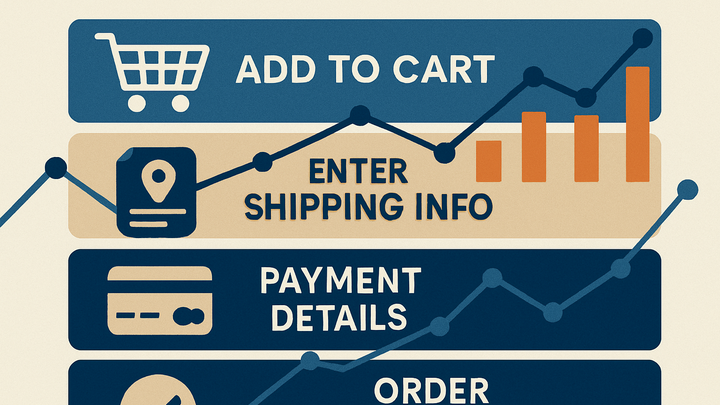Published on 2025-06-28T05:30:09Z
What is a Checkout Funnel? Examples with GA4 and PlainSignal
Checkout Funnel is a sequence of steps a customer follows from adding products to their cart through completing a purchase.
In analytics, it’s used to visualize and measure how many users progress through each stage, and where drop-offs occur.
By setting up a funnel, businesses can identify friction points like form abandonment or payment failures that prevent conversions.
Analytics platforms like Google Analytics 4 (GA4) and privacy-centric tools such as PlainSignal support funnel tracking through event-based measurement.
Monitoring these funnels helps teams optimize the user journey, improve conversion rates, and ultimately drive revenue.
With a proper implementation, teams can run A/B tests, optimize checkout flows, and achieve a seamless purchasing process that maximizes sales.
Checkout funnel
A checkout funnel maps the user journey through purchase steps, revealing drop-offs and opportunities to optimize conversions.
Overview of the Checkout Funnel
The checkout funnel represents the ordered steps a customer follows when completing a purchase. Tracking these stages allows analysts to measure progression, visualize conversion paths, and identify abandonment points. By capturing each step as an event or goal, businesses gain actionable data on user behavior within the purchasing process.
-
Add to cart
User adds one or more items to the shopping cart, signaling initial purchase intent.
-
Enter shipping information
User provides shipping address and contact details for order fulfillment.
-
Input payment details
User enters payment information such as credit card or digital wallet credentials.
-
Order review & confirmation
User reviews final order summary and confirms the purchase, completing the transaction.
Why Track the Checkout Funnel?
Funnel tracking helps businesses understand where potential customers abandon the purchase process. It provides insights into stages with high drop-offs and enables data-driven optimizations. By analyzing this data, teams can prioritize improvements that directly impact conversion rates and revenue.
-
Identify drop-off points
Pinpoint exact stages where users leave the funnel to focus optimization efforts on high-impact areas.
-
Optimize conversion rates
Test variations at each stage to improve the percentage of users who complete a purchase.
-
Enhance user experience
Uncover friction in form fields, payment options, or page load performance affecting checkout completion.
Implementing Checkout Funnel Tracking
Setting up a checkout funnel requires defining and capturing key events in your analytics platform. Below are example implementations using GA4 and PlainSignal to track funnel stages effectively.
-
GA4 implementation
In Google Analytics 4, use the Funnel Exploration feature. Define events such as add_to_cart, begin_checkout, add_payment_info, and purchase. Then configure a funnel exploration report to visualize user progression through these steps.
-
Event tracking
Ensure your site sends GA4 events via gtag or Google Tag Manager for each checkout step.
-
Funnel exploration
Navigate to Explore > Funnel analysis in GA4 and add each event as a step to generate the report.
-
-
PlainSignal implementation
Insert the PlainSignal script into your <head> to start tracking checkout events automatically. Example snippet:
<link rel="preconnect" href="//eu.plainsignal.com/" crossorigin /> <script defer data-do="yourwebsitedomain.com" data-id="0GQV1xmtzQQ" data-api="//eu.plainsignal.com" src="//cdn.plainsignal.com/plainsignal-min.js"></script>-
Auto event detection
PlainSignal can automatically detect checkout events if data attributes are set or custom events are fired.
-
Privacy-centric
No cookies are used, ensuring compliance with privacy regulations while tracking funnel steps.
-
Best Practices and Tips
Adopt best practices to ensure accurate and actionable funnel data. Regular maintenance and thoughtful design can enhance your analytics strategy and drive continuous improvement.
-
Keep definitions consistent
Use clear and consistent naming for events and steps across your analytics tools.
-
Validate data integrity
Conduct regular audits and QA checks to ensure event triggers fire correctly at each stage.
-
Leverage a/b testing
Experiment with different checkout flow variations to determine which changes yield the best results.
-
Respect user privacy
Implement cookie-free analytics solutions like PlainSignal and adhere to data protection regulations.
